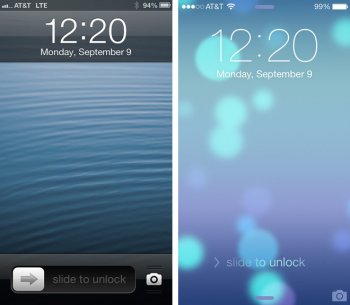The brand-new 'Press Home To Unlock' feature of the lock screen is, if not "very much" confusing for most previous iPhone users, quite a complicated approach just to unlock the device. The current prompt is just too small to notice, and sometimes hard to understand (Press Home To Unlock, then Press Home To Open). Compared to just swiping or tapping on the screen as used in almost all smartphones & tablets, 'Press Home To Unlock' is a bit odd, and even the label itself is not quite easy to get. Most people know that an iPhone, or an iOS device is pretty much unlocked with a slide. If not, with iOS 10, the user will start pressing everything, and possibly even ruin their workflow.
A suggested approach is to bring back 'familiarity', or integrate design with personal thinking on how a typical smartphone works. Any technology-oriented person recognizes that most smartphones require just a swipe to be unlocked without pressing buttons more than once. The solution is with the return of 'Slide To Unlock', however with a different UI tweak to still permit access to the similar gesture in bringing up the widget screen.
The result is the return of the once groundbreaking 'Slide To Unlock' bar slider.
Concept Mock-Up
Here is a design mock-up / illustration of the 'Slide To Unlock' interface merged with the familiar "bar slider" which is interactive, reminiscent on older versions of iOS:

> On the first set of photos is the former lock screen interface as depicted in iOS 6 and the current 'Slide To Unlock' user-interface as seen on an iPhone running iOS 7 (the gesture still exists up to iOS 9).
The second set of photos are the mock-up suggestions for 'Slide To Unlock' redesigned with a transparent-translucent 'sliding bar':



> First photo shows the round page indicators above the sliding bar.
> The second photo shows the round page indicators at their current position in iOS 10.
> The third photo shows the the sliding bar interfaced with 'Slide To Open' when the device is unlocked.
Design
A semi–transparent-translucent bar slider runs across the bottom of the screen, complete with an animation that makes the slider area fade away to trigger the passcode screen, where the use is promoted either to use Touch ID or enter their passcode. A 'padlock' icon is still present at the topmost portion of the lock screen, and still animates to show that it has 'Unlocked' if Touch ID has read the user's fingerprint. Thus, if the device is already unlocked, the 'Slide To Unlock' text will change to 'Slide To Open'.
> Note: 'Slide To Open' changes the function of 'Press to Open' when the device is unlocked. If the 'Rest Finger To Unlock' toggle is turned on, there is no need for 'Slide to Open'.
Small round page indicators still rest above / below the interface to show users that a swipe towards the right still opens the widget screen, and a right swipe still toggles the camera.
Benefits
With the return of the 'sliding bar' interface, it completely eliminates confusion on unlocking the iOS device. The return of the 'sliding bar' also prevents the opening of the widget screen.
Design-wise, it may still cause a little confusion with people migrating from an iOS 9 device, as swiping anywhere around the lock screen will just toggle the widget view. Overall, it is still an easier gesture for people to get used to.
As with the concept implemented in future iterations of iOS, if will also prevent more problems from occurring, such as inevitable hardware problems with the home button. People have various degrees of pressure when pressing the home button, such as when rushing, or forcing Touch ID to recognize their finger and proceed immediately, all of which can cause hardware failure. It should also be considered that half of iOS devices are not equipped with Touch ID, or have the Touch ID function not working or disabled. The Touch ID sensor on later devices currently makes the the iOS 10 lock screen change somewhat unnoticeable.
The move would also prevent confusion towards buyers trying out an iOS device in a local Apple Store, where one could have no clue how to open the device unless they find the small text of the current iOS 10 'Press Home To Open''.
Conclusion
All the aforementioned design tweaks can still be subjected for improvement. This concept can solve the problem of confusion between the majority of current users and new users to come.
A suggested approach is to bring back 'familiarity', or integrate design with personal thinking on how a typical smartphone works. Any technology-oriented person recognizes that most smartphones require just a swipe to be unlocked without pressing buttons more than once. The solution is with the return of 'Slide To Unlock', however with a different UI tweak to still permit access to the similar gesture in bringing up the widget screen.
The result is the return of the once groundbreaking 'Slide To Unlock' bar slider.
Concept Mock-Up
Here is a design mock-up / illustration of the 'Slide To Unlock' interface merged with the familiar "bar slider" which is interactive, reminiscent on older versions of iOS:

> On the first set of photos is the former lock screen interface as depicted in iOS 6 and the current 'Slide To Unlock' user-interface as seen on an iPhone running iOS 7 (the gesture still exists up to iOS 9).
The second set of photos are the mock-up suggestions for 'Slide To Unlock' redesigned with a transparent-translucent 'sliding bar':



> First photo shows the round page indicators above the sliding bar.
> The second photo shows the round page indicators at their current position in iOS 10.
> The third photo shows the the sliding bar interfaced with 'Slide To Open' when the device is unlocked.
Design
A semi–transparent-translucent bar slider runs across the bottom of the screen, complete with an animation that makes the slider area fade away to trigger the passcode screen, where the use is promoted either to use Touch ID or enter their passcode. A 'padlock' icon is still present at the topmost portion of the lock screen, and still animates to show that it has 'Unlocked' if Touch ID has read the user's fingerprint. Thus, if the device is already unlocked, the 'Slide To Unlock' text will change to 'Slide To Open'.
> Note: 'Slide To Open' changes the function of 'Press to Open' when the device is unlocked. If the 'Rest Finger To Unlock' toggle is turned on, there is no need for 'Slide to Open'.
Small round page indicators still rest above / below the interface to show users that a swipe towards the right still opens the widget screen, and a right swipe still toggles the camera.
Benefits
With the return of the 'sliding bar' interface, it completely eliminates confusion on unlocking the iOS device. The return of the 'sliding bar' also prevents the opening of the widget screen.
Design-wise, it may still cause a little confusion with people migrating from an iOS 9 device, as swiping anywhere around the lock screen will just toggle the widget view. Overall, it is still an easier gesture for people to get used to.
As with the concept implemented in future iterations of iOS, if will also prevent more problems from occurring, such as inevitable hardware problems with the home button. People have various degrees of pressure when pressing the home button, such as when rushing, or forcing Touch ID to recognize their finger and proceed immediately, all of which can cause hardware failure. It should also be considered that half of iOS devices are not equipped with Touch ID, or have the Touch ID function not working or disabled. The Touch ID sensor on later devices currently makes the the iOS 10 lock screen change somewhat unnoticeable.
The move would also prevent confusion towards buyers trying out an iOS device in a local Apple Store, where one could have no clue how to open the device unless they find the small text of the current iOS 10 'Press Home To Open''.
Conclusion
All the aforementioned design tweaks can still be subjected for improvement. This concept can solve the problem of confusion between the majority of current users and new users to come.








